Unlock the Magic: Your Comprehensive Guide to Ruby Gemstones
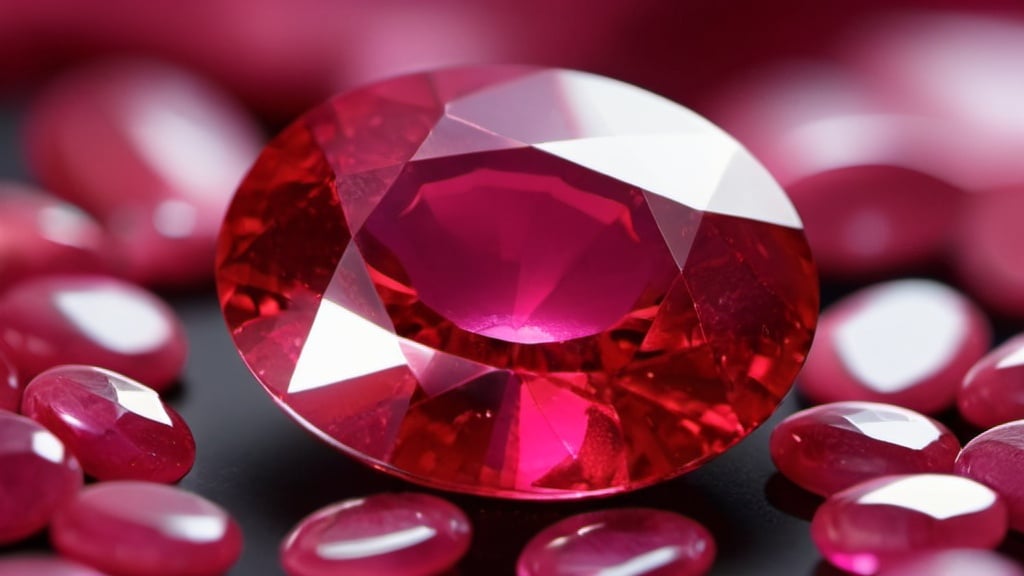
1. Introduction
A renaissance of the magical and religious qualities of the ruby took place in modern times with the allegorical bestowal of a magnificent pair of rubies and these virtues upon Aaron’s brother in the fictional classic Lord of the Rings. Today, the ruby still symbolizes the attributes that it has done throughout the ages. This book does not cover any treatments and synthetics of ruby.
In the Middle Ages, it was believed that a piece of ruby when worn on the left side of the body will enable the individual wearing it to live in peace with his enemies. It was thought to be an antidote against poison, plague, evil thoughts, and spirits. Worn by the warrior class, rubies were held to possess the virtue of successful and safe amorous adventures. They were considered the stone of love, energy, passion, power, and a zest for life. It was said that a ruby has the power to change color and glow with intensity according to the health of the person who wears it. He will be calm and at peace while the color is deep and bright. Help in achieving goals is said to be reached by placing a ruby under a pillow. It was also warned that the wearer of a ruby could look forward to unending danger in that it would become the target for the cupidity and oppression of those more powerful.
Both interesting and informative, this book covers the history and symbolism of Ruby, its importance in the modern gem and jewelry industry, and discusses new and sustainable sources of Ruby. Ruby has been known as the king of gemstones in ancient Sanskrit writings. According to Hindu belief, Ruby is the “ratnaraj” or the king of all precious stones which represent the sun. The glowing red color of ruby radiates energy and power. The main attraction to rubies is their color. Only red corundum is entitled to be called ruby, all other color varieties being classified as sapphires.
1.1 What are Ruby Gemstones?
Rubies are one of the most valuable stones on the market today, being referred to as the king of gems and accompanied with the synonyms “Imperial” or “Burmese” as a form of classification. The classification class changes the value of the stone considerably, sometimes by twice the amount, and means that some rubies are unaffordable for most people. Rubies from Myanmar are often assumed to be the best quality.
Rubies are the hardest natural stone and the hardest mineral after diamond, which is a great way to explain the value and toughness of this stone. The hardness of ruby refers to duty, and this is why rubies were chosen as a stone of great symbolic power to ancient royalty. Ruby’s toughness is very good and it represents a strong symbol of power, courage and leadership and has been chosen as the stone to represent the 40th and 15th wedding anniversaries.
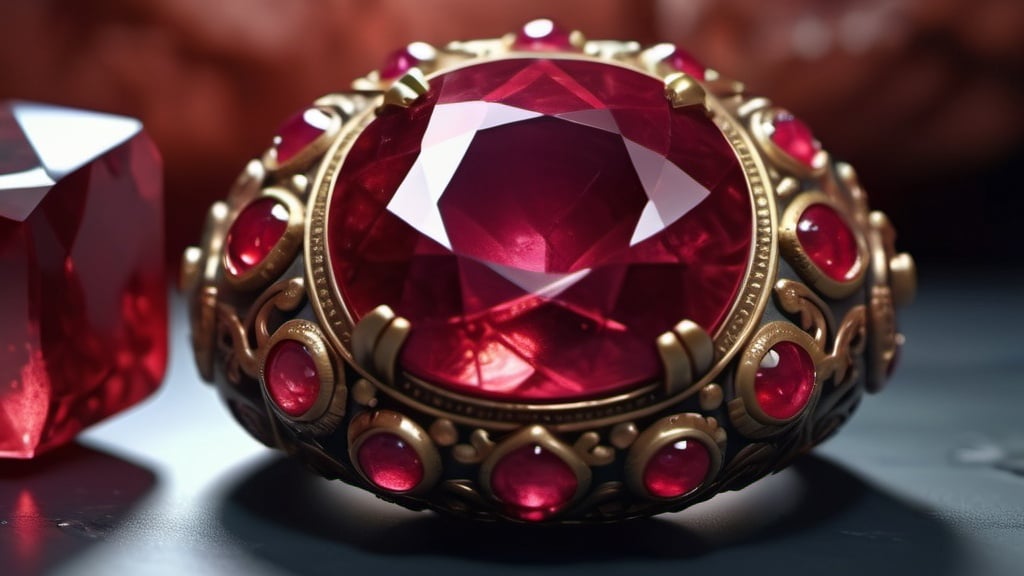
Ruby Gemstone in Pendent for Queen | Photo by 360 Real Astrology
The term “Ruby” is derived from the Latin word “ruber” which means “red”. Ruby is basically aluminum oxide with chromium. The color of ruby is due to the element chromium. The best shade of red for ruby is pigeon blood red. Chromium can give the stone a pinkish color, sometimes the term “pink sapphire” is used, although pink sapphire and ruby are the same stone, the classification of which differs depending upon the locality.
1.2 History and Symbolism of Ruby Gemstones
Ruby has always been associated with love, especially faithful passionate love. An old legend tells of a Burmese shepherd who many centuries ago found a large glowing ruby. He placed the crystal on his earlobe, and he found that he was no longer sad about the breakup with his girlfriend. He stored the ruby inside of his body, and he was filled with an overabundance of love for her and developed sexual vitality and overcame many obstacles to win her back.
Traditionally, many Indians believe that rubies help to bring financial stability to a person’s life. The Hindu belief is that if one offers a fine quality ruby to Krishna, one is reborn as an emperor in the future life. Hindus believe that those who wear a ruby are granted good fortune in their lives. This is attributed to the flawless crystal of ruby being as a drop of the heart’s blood of Mother Earth.
Ruby is a deep pink to red colored gemstone, a variety of the mineral corundum. Corundum occurs in a spectrum of colors, and when it is red to the color of a ruby, it is named so. Other varieties of gem-quality corundum are called sapphires. The word ruby comes from splendor in Latin. The word for ruby in Sanskrit is ratnaraj meaning king of precious stone.
1.3 Importance of Ruby Gemstones in Jewelry
In modern times, rubies are considered to be the most magnificent of all gems and are widely given as gifts perpetuating love and friendship. Ruby is the birthstone for those who are born in the month of July. Ruby gemstone jewelry is also the gem given for the fifteenth and fortieth anniversary. Ruby is also a symbol of vitality and royalty. When worn, it is believed to bring vitality and strength to the wearer. High-ranking officials also often wore rubies to symbolize their authority. The energy and intensity of the ruby is said to warm and stimulate the soul, and the wearer is said to experience a positive impact on their lives. Overall, the ruby is a perfect gemstone for those who desire a fine gem that is both unique and elegant.
Rubies are incredibly popular in jewelry because of their stunning color and their association with wealth and royalty. Throughout history, rubies have been considered to be the perfect gemstone, with the power to heal and promote good health. It was believed that if a ruby were placed in a pot of water, it would cause the water to boil. The early cultures also believed that if a ruby were embedded in the flesh of a man, it would cause him to be safe from harm. The ruby has also been thought of as a stone of prophecy. It has been said that a ruby was darker in color until danger was near, and then it would lighten. It has been thought that a ruby was an indication of evil or changing of color meant that there was danger and that it was no longer safe.
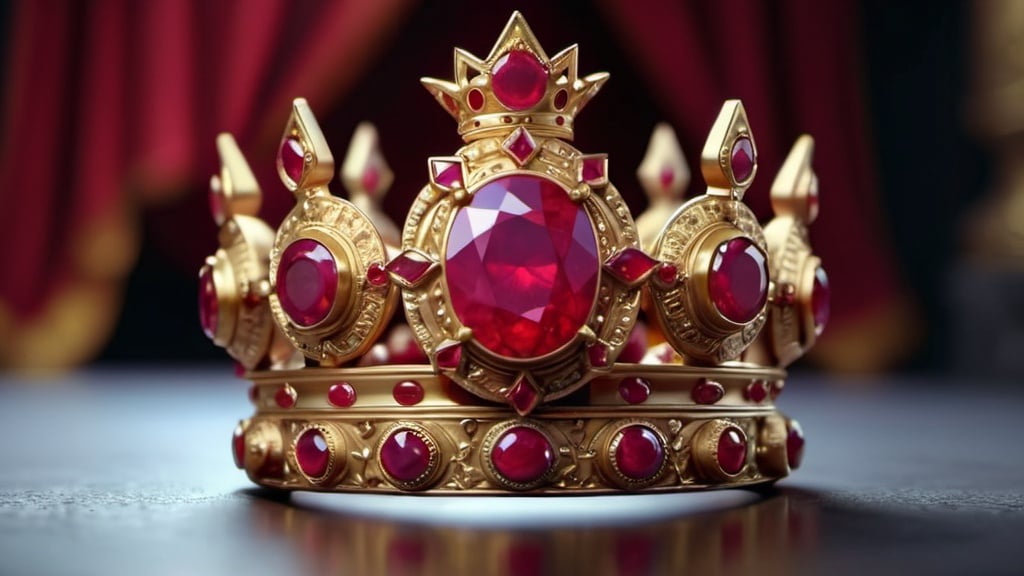
Ruby Gemstone in Crown for Kings | Photo by 360 Real Astrology
2. Characteristics of Ruby Gemstones
Rubies are considered the king of gems and represent love, health, and wisdom. It was believed that wearing a fine red ruby bestowed good fortune on its owner. A ruby is the most valuable of all precious stones. The finest ruby is best described as being a vivid medium-dark toned red. It is neither orange nor purplish, but a fine pure red. The color of ruby is its most important quality factor. Fine gems are generally medium to medium-dark tone. A large number of various colors, given to corundum by the oxides of metallic elements, have been described, but many of them are so rare and fugitive as to be negligible as factors in the value of the stones. The yellow, pink, and the various shades of green are caused by certain chemical impurities in the stone, but the coloring is not a decided one and can be removed more easily than in the case of the red, the blue, and the violet. Blue stones are now known as sapphires, the red being the variety of corundum known as “oriental ruby.” The word ruby, the name for red corundum, itself carries connotations of power, desire, and love, given its importance to the peoples of so many different times and places. The word comes from the Latin “ruber,” meaning red. Rubies are usually given a mixed cut, a hybrid between a brilliant cut and a step cut. Value in a mixed cut is between a step-cut stone and a brilliant cut stone of the same quality. Thai rubies often receive brilliant cuts. Ruby, the red variety of corundum, is a very brilliant gem, being of high refractive index and in its best qualities.
2.1 Physical Properties of Ruby Gemstones
One of the most important factors in determining the quality of a ruby. Ideally, a ruby will be totally clean with no visible inclusions. This is very rare in rubies over a few carats and in some light conditions can make a stone have a glassy or “sleepy” appearance. However, some inclusions can be tolerated if they do not overly detract from the overall beauty of the stone, but in general, the more transparent the ruby, the more valuable it is. Rubies with nearly no inclusions are categorized as ‘clean’ and are significantly more valuable than those with inclusions, even if they cannot be seen by the naked eye. Rubies may also be filled with fractures or cavities, and this process, provided it is fully disclosed to the buyer, can improve the appearance of a stone and is accepted as a standard practice within the trade. Rubies with fractures that have been filled are usually valued at around 50% less than those without. Rubies are often subjected to various forms of enhancing. This is a traditional and accepted practice within the trade. The most common form of enhancement is heat treatment, which has been used for centuries. This involves heating the ruby almost to its melting point, but not to the extent that it becomes liquid, in order to improve color and clarity. Nearly all rubies on the market today are heat treated, and it is a permanent treatment that should not have any negative effects. It is not uncommon for rubies to also be filled with a foreign material to improve the appearance of fractures; this is a more temporary treatment and should always be fully disclosed to the buyer, as the filled fractures can be damaged if the ruby is subjected to high temperatures during repair work. Other, less common enhancements include lattice diffusion and glass filling; these treatments are usually reserved for lower quality stones as the aim is to improve their appearance to that of a higher price bracket. It is important that all enhancements are fully disclosed to the buyer, and it is illegal in many countries to sell an enhanced ruby without fully disclosing such treatments. Full disclosure allows the buyer to make an informed decision on the value of the stone and diminishes the risk of damage to the ruby if treatments are not known.
2.2 Color Variations and Grading of Ruby Gemstones
Ruby colors everything surrounding it. Its character ranges from deep red to pale orange. The primary color of ruby mixed with purple is the universally recognized color of quality ruby. The color varies greatly from lighter pink to blood red. The lighter pink colors are generally in the lower price range because they are less rare than the deep blood red colored rubies. If the color of the ruby is too dark, it has a negative impact because it affects the refraction of light that passes through the stone. Light should penetrate a ruby and be reflected internally from the polished surface in the stone, then reemerge and return to the observer’s eye. If the stone is too dark, the light is absorbed and cannot return to the beholder’s eye. This is why deep red rubies, not too dark, are considered to be of the best quality.
2.3 Clarity and Cut of Ruby Gemstones
Most rubies today are treated in some form to improve the color and clarity of the stone. The most common treatment is heat treatment, which improves the color dramatically. The treatment of heating ruby is well known to gemologists and professional buyers, and in most countries sellers are required to disclose the presence of treated gems. Another common treatment is filling fractures in rubies with lead glass; these fractures can be seen as a shiny network of lines under a magnifying lens. The amount of lead glass can significantly affect the appearance of a ruby by weakening the overall brilliance of the stone, and it also significantly reduces the value of a ruby, so the use of glass as a filler is often not mentioned with the sale of lead glass treated rubies. Ruby is also subjected to other treatments such as flow drilling. A greyish green hue is a common result of heat treatment. High-temperature treated rubies with any enhancement other than low temperature bulk glass should be cleaned with an ultrasonic cleaner.
The clarity of a ruby is determined by the presence of inclusions, which are natural internal flaws, and external flaws. Inclusions generally decrease the value of a ruby, but some types of inclusions increase the value, depending on their effect on the gem’s overall appearance. Some inclusions such as tiny, fine needles of rutile silk give a silver or spark in a ruby, and if cut as a cabochon may create a six-ray star. Rubies without any inclusions visible to the naked eye are considered flawless and are highly sought after. An external flaw, if deep enough, can cause a ruby to have a weakened or dulled brilliance. If the external flaws affect the internal clarity, then the value of the ruby is significantly decreased.
3. Sourcing and Authenticity of Ruby Gemstones
When buying rubies, it is important to be well informed as to the sources and identification of the stones available on the market. Much research has been conducted in recent years on the correlation between the geographical origin of a ruby and its inclusions and colour, which has resulted in the development of new treatments for creating synthetic stones, and the enhancement of already existing methods. This has contributed to a complex situation in the ruby industry, where consumers are often misinformed, prices are biased, and certification either unavailable or unreliable. In some cases, stones are smuggled across borders to be sold in another country with the claim that they are from a more valuable source. An example of this is the trade of low quality Mong Hsu rubies, which can be found in Mongolian markets and are wrongly claimed to be Burmese. Due to the recent political climate in Burma, there has been a ban on the export of Burmese gemstones to Western countries. While this boycott has helped to deplete global stocks of top quality Burmese stones, it has prompted the treatment of African or other Asian stones to imitate Burmese colour and increase their value. This creates an uncertain situation for the consumer who is unsure about the origin of a stone and unable to differentiate between treated and untreated stones. Local Thai and Burmese jewellers may have more knowledge about their geographic neighbours and the treatments that their stones have undergone, although this may be biased by a desire to sell their own local products.
3.1 Major Ruby Deposits around the World
Rubies are found in many areas that include: Africa, Asia, Australia, Greenland, Europe, and North America. Many of the rubies from these localities are important. Those from Myanmar are especially prized and have a rich, full red color that is unmatched. Rubies from Thailand have a brownish tone. These rubies are generally heated in a furnace to enhance the color and to reduce the purple and brown tones; this is a standard treatment. Rubies from Africa can vary from a pure red to a more pinkish tone. Some rubies from Africa are easily mistaken for garnets. Today, rubies are also found in India and are of good quality. Ruby deposits in Pakistan and Afghanistan are becoming increasingly important and are of a similar good color to the Indian rubies. North American rubies from the USA and Canada are usually a light pinkish-red color and are seldom found in sizes above a few carats.
3.2 Identifying Genuine Ruby Gemstones
Currently, over 80% of rubies contaminated by lead glass are being sold onto the Thai market as heat-treated/filled rubies. Glass-filled rubies can be extremely difficult to detect without professional advice. Lead Glass has a similar refractive index to ruby, so the filled areas do not mist or cloud. This means that the clarity and color flaws which would highlight a fissure/ruby filled with lead glass are not present. Glass-filled rubies have been known to change into new pieces of glass after repolishing. With the high number of glass-filled rubies making it into the market, them becoming less visible over time, and the fact that many jewelers are unaware that their stock may be glass-filled, it is worth checking the status of a ruby purchased before 2005.
Synthetic ruby is, as the name suggests, not a real ruby. Created in labs, synthetic rubies are produced using different methods, primarily the Flame Fusion method, Flux method, and the High Pressure High Temperature (HPHT) method. The Flame Fusion and Flux methods were developed over 100 years ago, with the HPHT method coming into use more recently. The Flame Fusion method involves the melting of fine alumina powder and trace chrome in a high-temperature furnace. A boule will then form as the flame re-crystallizes the molten material while it cools down. The Flux method also involves melting, but the material is then cut by a preform crystal seed that is dipped into the flux.
The identification of a genuine ruby is one of the most important aspects for anyone purchasing ruby jewellery, be it a ruby engagement ring or a pendant. A genuine ruby is not the same as a synthetic or a glass-filled ruby, and the difference in quality and price between the two is considerable. A genuine ruby will be a worthwhile investment, a synthetic or glass-filled ruby will not.
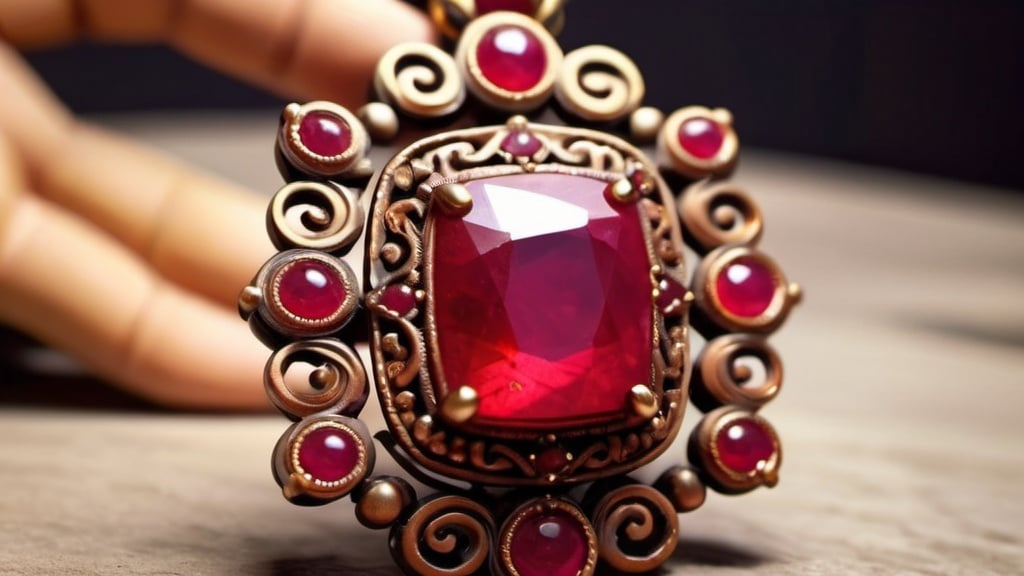
Ruby Gemstone using as talismanic stone for Royal Family | Photo by 360 Real Astrology
3.3 Certification and Verification of Ruby Gemstones
When it comes to valuing a ruby, it’s important to know the difference between a natural, synthetic, or treated stone. It is alarming that synthetic rubies are often passed off as natural stones to the unassuming buyer. A qualified gemologist can distinguish between a natural and synthetic ruby by examining the inclusions with a microscope. It is quite difficult to detect the many treatments that ruby goes under to enhance its appearance. Some treatments are acceptable and do improve the appearance of the stone, such as heat treatment, which is widely used and accepted. However, there are other treatments that have a more negative effect on the stone’s value, and transparency about these is often low. This may lead to a situation where it is unclear to the buyer whether their ruby is genuinely worth the price that was paid for it. A good example is a lead-glass treatment, which is used to add perceived clarity and brilliance to a stone, often in a bid to conceal the fact that it is overly included. Rubies that have been treated in any way should be accompanied by a disclosure from the seller. This provides information on the nature of the treatment and any special care required because of it. Disclosure is an important part of certification, and any respectable certification of a ruby will clearly identify whether it is natural or treated.
4. Caring for Ruby Gemstones
To keep their beauty and shine, rubies must be taken care of. Rubies are generally easy to care for. The best way to clean a ruby is to use a soft bristle brush and warm soapy water. It is best to keep your jewelry clean, as dirt and oils can build up in the setting, taking away from the brilliance of the stone. It is best to have any damage to the stone or the setting of the stone repaired right away. If the stone is damaged, it may wash out or become very noticeable if not repaired quickly. Ruby is a very durable stone; however, it may still become scratched or chipped if it is not carefully stored. Ruby should not be stored with other harder stones that may scratch it. Ideally, it is best to have a fabric-lined jewelry box with separate compartments or a lined pouch to store rubies. A jeweler can further advise you on how to properly care for your ruby or ruby jewelry.
4.1 Cleaning and Maintenance of Ruby Gemstones
Rubies should not be cleaned using strong chemicals or immersed in any solution containing chlorine bleach.
Steam cleaning rubies is not recommended as there is a risk that the fracture filling will become damaged. Fracture filling is a treatment that is commonly done with rubies, and it involves the filling of surface-reaching breaks with glass to improve the look of the ruby. This filling can be damaged by the heat of a steam cleaner or by the use of any other method that is too abrasive.
The best way to clean your rubies is to use a mild detergent or soapy water with a soft brush. The brush can be an old toothbrush, a manicure brush, or a brush specifically designated for cleaning your jewelry. A home ultrasonic cleaner can also be used, but it is not recommended by all as it can sometimes shake the setting or chip the ruby.
To care for your valuable rubies properly, you should know that the durability of the mountings and other gemstones in the jewelry will affect the methods you should use when caring for rubies. Ruby is the hardest mineral after diamond, and on Mohs Scale of Hardness, it has a rating of 9. This makes it a durable gemstone for use in jewelry. Despite this, rubies still require proper care.
4.2 Storing and Protecting Ruby Gemstone Jewelry
When storing and protecting rubies, you should first of all consider that the ruby has the ability to scratch other items, especially other gemstones. Remember to store your rubies separately or wrapped in cloth in a jewelry box. Just because rubies are durable, it doesn’t mean you shouldn’t afford them the proper care. Dust and grease can be removed with a cloth and soap and water. Often, the simple use of a soft brush to remove any build-up of dirt will bring back the ruby’s original brilliance. These procedures are safe for occasional cleaning, though the use of commercial cleaning solutions, especially those containing ammonia, should be avoided as they can damage your ruby or the jewelry settings. It is always a good idea to take your ruby jewelry to a professional jeweler for cleaning as they can also check the setting and mountings to ensure that the rubies are secure. This is also an opportunity to have the jeweler check for any damage to the mountings, which can become loose or worn, especially if you have rings or bracelets that you wear frequently. Heavily included or fractured rubies should be occasionally checked for residual staining or foreign material. Any kind of fracture filling, including high-lead content glass, can be damaged by repolishing or any kind of high-temperature treatment, such as that used for jewelry repair or fabrication, or household repair or renovation that involves the use of a torch or solder, often more heat than is required for ruby treatment in specific (see enhancements and treatments for more detail). It is always a good idea to take your ruby jewelry to a professional jeweler for cleaning as they can also check the setting and mountings to ensure that the rubies are secure. This is also an opportunity to have the jeweler check for any damage to the mountings, which can become loose or worn, especially if you have rings or bracelets that you wear frequently.
4.3 Enhancements and Treatments of Ruby Gemstones
Heat Treatments: Heat treatment of rubies is a common and an ancient enhancement practice. Normally occurring at temperatures between 1700 and 1800 degrees Celsius, the purpose of this process is to improve both color and clarity. Rubies are placed in a crucible which is already heated and are left in there from a few minutes to a few days with or without oxygen present. Firstly, color can be improved through high-temperature melting of the chromophores within the stone. This process dissolves rutile silk and partially filling existing fractures, therefore causing light to refract better and improving the stone’s clarity. An extra added impregnation of lead glass can also be added to the stone post-heating to again, improve clarity. Lead glass also has a similar refractive index to a ruby so refraction is improved and double refraction is reduced. Lead glass impregnation and fracture filling is also commonly applied to smoked quartz in an attempt to pass it off as a low-grade smoky topaz or citrine. Lead glass-filled rubies are easily spotted with a 10x loupe as gaseous bubbles and striae are visible. Lead glass to ruby impregnation may very well become an illegal practice as there are the often irreversible effects caused to the stone and may be seen as a breach of the Beryllium treatments and diffusion treatments case in 2006.
The ancient practice of ‘enhancing’ gemstones has been carried through to recent times. As gemstones are rare and finite, the logic is that the more attractive (commercially or aesthetically) a gemstone is, the more it will be worth. But how do you improve something that is millions of years old and has come through constant elemental and environmental abuse refinement? Modern technology allows for many treatments possible on gemstones; these include heat treatment, fracture filling, dyeing, impregnation, and irradiation treatments to name a few. There is no plan to cover all of these treatments, but rather to concentrate on those treatments applied to ruby gemstones.
References:
Ramesh, Thennakoon Gamage, et al. “Identification of the Effect of Localization on the Colour Alteration of “Geuda” Gemstones Through the Heat Treatment Using ED-XRF, FTIR, and UV-Vis Spectroscopic Analysis.” International Journal of Earth Sciences Knowledge and Applications 5.3 (2023): 324-332. dergipark.org.tr
Karampelas, Stefanos, et al. “Gem treatments, synthetics and imitations.” Gems and Gemmology: An Introduction for Archaeologists, Art-Historians and Conservators (2020): 67-90. [HTML]
Karampelas, S., Kiefert, L., Bersani, D., and Vandenabeele, P. “Gems and Gemmology.” 2020. academia.edu
Nelson, Kamaria, et al. “Cosmetic Enhancement Updates and Pitfalls in Patients of Color.” Dermatologic Clinics 41.3 (2023): 547-555. [HTML]
Gao, Yujie, et al. “Ruby from Longido, Tanzania: Mining, Color, Inclusion, and Chemical Features.” Crystals 14.4 (2024): 383. mdpi.com
Habibi, Fariborz, et al. “Anthocyanin in blood oranges: A review on postharvest approaches for its enhancement and preservation.” Critical Reviews in Food Science and Nutrition 63.33 (2023): 12089-12101. [HTML]
Thongnopkun, Pimthong, et al. “Application of Fourier-transformed infrared spectroscopy and machine learning algorithm for gem identification.” Artificial Intelligence and Spectroscopic Techniques for Gemology Applications. Bristol, UK: IOP Publishing, 2022. 3-1. [HTML]
Rossi, Manuela, et al. Mechanism of Be-Thermodiffusion in Rutile Inclusions of Fancy Sapphires.” Crystal Growth & Design 22.11 (2022): 6493-6503. acs.org
Jeršek, M., Jovanovski, G., Boev, B., and Makreski, P. “Intriguing minerals: corundum in the world of rubies and sapphires with special attention to Macedonian rubies.” ChemTexts, 2021. ugd.edu.mk
Hafiz, Ishfaq Ahmed, et al. “Boron’s exogenous-spraying and the postharvest quality of perlette and kings ruby Cvs. grapes by enhancing the gas exchange, antioxidants, and total sugars.” Journal of Biobased Materials and Bioenergy 16.1 (2022): 77-88. researchgate.net





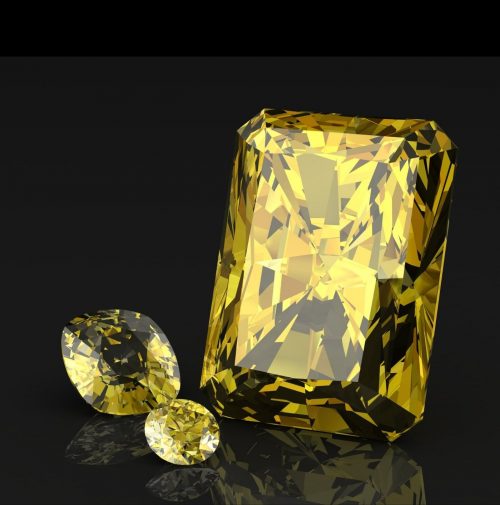
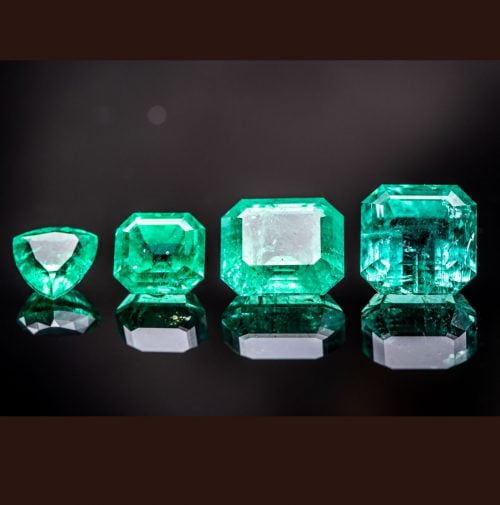

Connect me